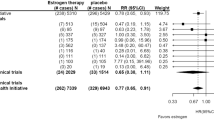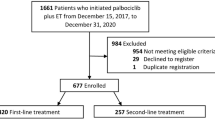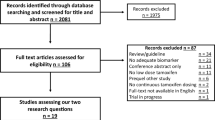Abstract
Purpose
The link between lipid-stabilizing medications and epithelial ovarian carcinogenesis is incompletely understood. Statins may reduce ovarian cancer risk, but results are inconclusive.
Methods
We conducted a systematic review and meta-analysis of studies reporting associations between statin use and ovarian cancer risk in PubMed. Summary risk ratios (RRs) and confidence intervals (CIs) were calculated. Subgroup analyses by cancer histotype, statin class (lipo- or hydrophilic) and duration of statin use were conducted. Use of individual statins in populations was assessed to determine population-specific differences in statin types.
Results
Nine studies with 435,237 total women were included (1 randomized controlled trial (RCT); 4 prospective; 4 case–control). Statin use was associated with a reduced risk of ovarian cancer (RR 0.87, 95% CI 0.74–1.03) and risk was significantly reduced in populations with low pravastatin use (RR 0.83, 95% CI 0.70–0.99). Risk estimates varied by statin class (3 studies; lipophilic: RR 0.88, 95% CI 0.69–1.12; hydrophilic: RR 1.06, 95% CI 0.72–1.57) and cancer histotype (3 studies; serous: RR 0.95, 95% CI 0.69–1.30; clear cell: RR 1.17, 95% CI 0.74–1.86). Long-term use was associated with a reduced risk of ovarian cancer (RR 0.77, 95% CI 0.54–1.10) that further reduced when pravastatin use was low (RR 0.68, 95% CI 0.46–1.01). Between-study heterogeneity was high overall and in subgroups (I2 > 60%).
Conclusion
Statins may be associated with a reduced risk of ovarian cancer, but the effect likely differs by individual statin, duration of use and cancer histotype. Additional well-powered studies are needed to elucidate important subgroup effects.




Similar content being viewed by others
Abbreviations
- RR:
-
Risk ratio
- OR:
-
Odds ratio
- CI:
-
Confidence interval
- PRISMA:
-
Preferred Reporting Items for Systematic Reviews and Meta-Analyses
- NOS:
-
Newcastle-Ottowa Scale
- NEC:
-
New England Case–Control study
References
Bray F, Ferlay J, Soerjomataram I, Siegel RL, Torre LA, Jemal A (2018) Global cancer statistics 2018: GLOBOCAN estimates of incidence and mortality worldwide for 36 cancers in 185 countries. CA Cancer J Clin 68:394–424
Buys SS, Partridge E, Black A et al (2011) Effect of screening on ovarian cancer mortality: the Prostate, Lung, Colorectal and Ovarian (PLCO) Cancer Screening Randomized Controlled Trial. JAMA 305:2295–2303
Jacobs IJ, Menon U, Ryan A et al (2016) Ovarian cancer screening and mortality in the UK Collaborative Trial of Ovarian Cancer Screening (UKCTOCS): a randomised controlled trial. Lancet 387:945–956
Jemal A, Siegel R, Ward E, Hao Y, Xu J, Thun MJ (2009) Cancer statistics, 2009. CA Cancer J Clin 59:225–249
Ness RB, Cottreau C (1999) Possible role of ovarian epithelial inflammation in ovarian cancer. J Natl Cancer Inst 91:1459–1467
Lee AW, Tyrer JP, Doherty JA et al (2015) Evaluating the ovarian cancer gonadotropin hypothesis: a candidate gene study. Gynecol Oncol 136:542–548
Wentzensen N, Poole EM, Trabert B et al (2016) Ovarian cancer risk factors by histologic subtype: an analysis from the ovarian cancer cohort consortium. J Clin Oncol 34:2888–2898
Long J, Zhang CJ, Zhu N et al (2018) Lipid metabolism and carcinogenesis, cancer development. Am J Cancer Res 8:778–791
Neagu M, Constantin C, Popescu ID et al (2019) Inflammation and metabolism in cancer cell-mitochondria key player. Front Oncol 9:348
Sciacovelli M, Gaude E, Hilvo M, Frezza C (2014) The metabolic alterations of cancer cells. Method Enzymol 542:1–23
Niemi RJ, Braicu EI, Kulbe H et al (2018) Ovarian tumours of different histologic type and clinical stage induce similar changes in lipid metabolism. Br J Cancer 119:847–854
Rasmussen CB, Kjaer SK, Albieri V et al (2017) Pelvic inflammatory disease and the risk of ovarian cancer and borderline ovarian tumors: a pooled analysis of 13 case-control studies. Am J Epidemiol 185:8–20
Sieh W, Salvador S, McGuire V et al (2013) Tubal ligation and risk of ovarian cancer subtypes: a pooled analysis of case-control studies. Int J Epidemiol 42:579–589
Trabert B, Ness RB, Lo-Ciganic WH et al (2014) Aspirin, nonaspirin nonsteroidal anti-inflammatory drug, and acetaminophen use and risk of invasive epithelial ovarian cancer: a pooled analysis in the Ovarian Cancer Association Consortium. J Natl Cancer Inst 106:djt431
Olsen CM, Nagle CM, Whiteman DC et al (2013) Obesity and risk of ovarian cancer subtypes: evidence from the ovarian cancer association consortium. Endocr Relat Cancer 20:251–262
Pearce CL, Templeman C, Rossing MA et al (2012) Association between endometriosis and risk of histological subtypes of ovarian cancer: a pooled analysis of case-control studies. Lancet Oncol 13:385–394
Vallianou NG, Kostantinou A, Kougias M, Kazazis C (2014) Statins and cancer. Anticancer Agents Med Chem 14:706–712
Shi J, Liu B, Wang H, Zhang T, Yang L (2019) Association of metformin use with ovarian cancer incidence and prognosis: a systematic review and meta-analysis. Int J Gynecol Cancer 29:140–146
Demierre MF, Higgins PD, Gruber SB, Hawk E, Lippman SM (2005) Statins and cancer prevention. Nat Rev Cancer 5:930–942
Jain MK, Ridker PM (2005) Anti-inflammatory effects of statins: clinical evidence and basic mechanisms. Nat Rev Drug Discov 4:977–987
Kusama T, Mukai M, Ayaki M et al (2003) Inhibition of lysophosphatidic acid-induced RhoA activation and tumor cell invasion by 3-hydroxy-3-methylglutaryl-coenzyme A reductase inhibitors. Int J Oncol 23:1173–1178
Binnington B, Nguyen L, Kamani M et al (2016) Inhibition of Rab prenylation by statins induces cellular glycosphingolipid remodeling. Glycobiology 26:166–180
Meikle PJ, Wong G, Tan R et al (2015) Statin action favors normalization of the plasma lipidome in the atherogenic mixed dyslipidemia of MetS: potential relevance to statin-associated dysglycemia. J Lipid Res 56:2381–2392
Gu QP-RR, Burt VL, Kit BK (2014) Prescription cholesterol-lowering medication use in adults aged 40 and over: United States, 2003–2012. NCHS data brief, no. 177. National Center for Health Statistics, Hyattsville
O'Keeffe AG, Petersen I, Nazareth I (2015) Initiation rates of statin therapy for the primary prevention of cardiovascular disease: an assessment of differences between countries of the UK and between regions within England. BMJ Open 5:e007207
Salami JA, Warraich H, Valero-Elizondo J et al (2017) National trends in statin use and expenditures in the US adult population from 2002 to 2013: insights from the medical expenditure panel survey. JAMA Cardiol 2:56–65
Kato S, Smalley S, Sadarangani A et al (2010) Lipophilic but not hydrophilic statins selectively induce cell death in gynaecological cancers expressing high levels of HMGCoA reductase. J Cell Mol Med 14:1180–1193
Duncan RE, El-Sohemy A, Archer MC (2005) Statins and cancer development. Cancer Epidemiol Biomarkers Prev 14:1897–1898
Akinwunmi B, Vitonis AF, Titus L, Terry KL, Cramer DW (2019) Statin therapy and association with ovarian cancer risk in the New England Case Control (NEC) study. Int J Cancer 144:991–1000
Lavie O, Pinchev M, Rennert HS, Segev Y, Rennert G (2013) The effect of statins on risk and survival of gynecological malignancies. Gynecol Oncol 130:615–619
Yu O, Boudreau DM, Buist DS, Miglioretti DL (2009) Statin use and female reproductive organ cancer risk in a large population-based setting. Cancer Causes Control CCC 20:609–616
Kaye JA, Jick H (2004) Statin use and cancer risk in the general practice research database. Br J Cancer 90:635–637
Bathaie SZ, Ashrafi M, Azizian M, Tamanoi F (2017) Mevalonate pathway and human cancers. Curr Mol Pharmacol 10:77–85
Liu Y, Qin A, Li T, Qin X, Li S (2014) Effect of statin on risk of gynecologic cancers: a meta-analysis of observational studies and randomized controlled trials. Gynecol Oncol 133:647–655
Wang Y, Ren F, Song Z, Chen P, Liu S, Ouyang L (2019) Statin use and the risk of ovarian and endometrial cancers: a meta-analysis. BMC Cancer 19:730
Moher D, Liberati A, Tetzlaff J, Altman DG, PRISMA Group (2009) Preferred reporting items for systematic reviews and meta-analyses: the PRISMA statement. J Clin Epidemiol 62:1006–1012
Wells GASB, O’Connell D, Peterson J, Welch V, Losos M (2009) The Newcastle-Ottowa Scale (NOS) for assessing the quality of nonrandomized studies in meta-analyses. Ottawa Hospital Research Institute, Ottawa
Greenland S (1987) Quantitative methods in the review of epidemiologic literature. Epidemiol Rev 9:1–30
Baandrup L, Dehlendorff C, Friis S, Olsen JH, Kjaer SK (2015) Statin use and risk for ovarian cancer: a Danish nationwide case-control study. Br J Cancer 112:157–161
Friedman GD, Flick ED, Udaltsova N, Chan J, Quesenberry CP Jr, Habel LA (2008) Screening statins for possible carcinogenic risk: up to 9 years of follow-up of 361,859 recipients. Pharmacoepidemiol Drug Saf 17:27–36
Clearfield M, Downs JR, Weis S et al (2001) Air Force/Texas Coronary Atherosclerosis Prevention Study (AFCAPS/TexCAPS): efficacy and tolerability of long-term treatment with lovastatin in women. J Womens Health Gend Based Med 10:971–981
Desai P, Wallace R, Anderson ML et al (2018) An analysis of the association between statin use and risk of endometrial and ovarian cancers in the Women's Health Initiative. Gynecol Oncol 148:540–546
Urpilainen E, Marttila M, Hautakoski A et al (2018) The role of metformin and statins in the incidence of epithelial ovarian cancer in type 2 diabetes: a cohort and nested case-control study. BJOG Int J Obstet Gynaecol 125:1001–1008
Jick H, Wilson A, Wiggins P, Chamberlin DP (2012) Comparison of prescription drug costs in the United States and the United Kingdom, Part 1: statins. Pharmacotherapy 32:1–6
Shalev V, Weil C, Raz R, Goldshtein I, Weitzman D, Chodick G (2014) Trends in statin therapy initiation during the period 2000–2010 in Israel. Eur J Clin Pharmacol 70:557–564
Mortensen MB, Falk E, Schmidt M (2017) Twenty-Year Nationwide Trends in Statin Utilization and Expenditure in Denmark. Circ Cardiovasc Qual Outcomes 10:e003811
Li YY, Zhang WC, Zhang JL et al (2015) Plasma levels of lysophosphatidic acid in ovarian cancer versus controls: a meta-analysis. Lipids Health Dis 14:72
Kabat GC, Kim MY, Chlebowski RT, Vitolins MZ, Wassertheil-Smoller S, Rohan TE (2018) Serum lipids and risk of obesity-related cancers in postmenopausal women. Cancer Causes Control CCC 29:13–24
Hindler K, Cleeland CS, Rivera E, Collard CD (2006) The role of statins in cancer therapy. Oncologist 11:306–315
Beckwitt CH, Shiraha K, Wells A (2018) Lipophilic statins limit cancer cell growth and survival, via involvement of Akt signaling. PLoS ONE 13:e0197422
Faber MT, Kjaer SK, Dehlendorff C et al (2013) Cigarette smoking and risk of ovarian cancer: a pooled analysis of 21 case-control studies. Cancer Causes Control CCC 24:989–1004
Sacks FM, Pfeffer MA, Moye LA et al (1996) The effect of pravastatin on coronary events after myocardial infarction in patients with average cholesterol levels. Cholesterol and Recurrent Events Trial investigators. N Engl J Med 335:1001–1009
Shepherd J, Blauw GJ, Murphy MB et al (2002) Pravastatin in elderly individuals at risk of vascular disease (PROSPER): a randomised controlled trial. Lancet 360:1623–1630
Gong L, Xiao Y, Xia F et al (2019) The mevalonate coordinates energy input and cell proliferation. Cell Death Dis 10:327
Hamelin BA, Turgeon J (1998) Hydrophilicity/lipophilicity: relevance for the pharmacology and clinical effects of HMG-CoA reductase inhibitors. Trends Pharmacol Sci 19:26–37
Greenaway JB, Virtanen C, Osz K et al (2016) Ovarian tumour growth is characterized by mevalonate pathway gene signature in an orthotopic, syngeneic model of epithelial ovarian cancer. Oncotarget 7:47343–47365
Kobayashi Y, Kashima H, Rahmanto YS et al (2017) Drug repositioning of mevalonate pathway inhibitors as antitumor agents for ovarian cancer. Oncotarget 8:72147–72156
Funding
This work was funded by the Intramural Research Program of the National Cancer Institute.
Author information
Authors and Affiliations
Corresponding author
Ethics declarations
Conflict of interest
The authors declare no potential conflicts of interest.
Additional information
Publisher's Note
Springer Nature remains neutral with regard to jurisdictional claims in published maps and institutional affiliations.
Electronic supplementary material
Below is the link to the electronic supplementary material.
Rights and permissions
About this article
Cite this article
Irvin, S., Clarke, M.A., Trabert, B. et al. Systematic review and meta-analysis of studies assessing the relationship between statin use and risk of ovarian cancer. Cancer Causes Control 31, 869–879 (2020). https://doi.org/10.1007/s10552-020-01327-8
Received:
Accepted:
Published:
Issue Date:
DOI: https://doi.org/10.1007/s10552-020-01327-8




